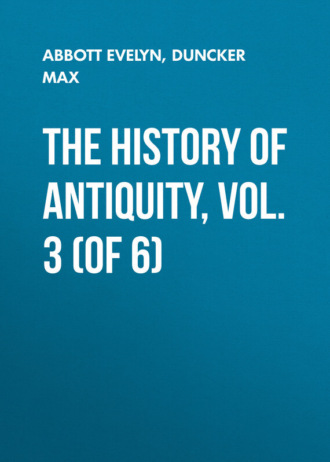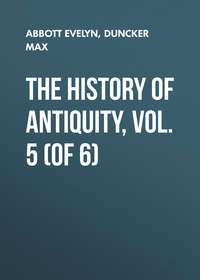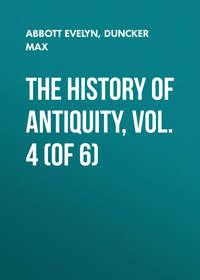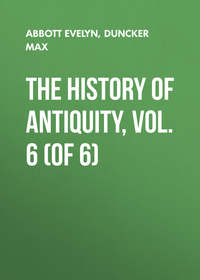 полная версия
полная версияThe History of Antiquity, Vol. 3 (of 6)
Let us first examine each of the two accounts separately. In Ctesias the motives of the actors, the interpretations of dreams and constellations, all the incidents and occurrences, are known. He is acquainted with the conversations which Arbaces and Belesys carry on at the gate of the palace at Nineveh, and in their walks on the banks of the Tigris – and knows how they intend to divide the lion's skin before it is won. The effeminate life and nature of the king of Asshur are described in the strongest traits and with the most minute detail. Yet this effeminate man has a lawful wife, with whom he ends his existence, three sons and two daughters, whom, in his care for their lives, he sends away before Nineveh is shut up. After a life passed in the harem, an effeminate ruler, such as this account describes the last king of Assyria to have been, might, under the pressure of great danger, perhaps put himself to death; but he could hardly have the resolution and the capacity to struggle for three years, with heroic courage and obstinacy, for his kingdom and throne. In the narrative of Ctesias this effeminate king three times vanquishes his opponents in great battles. The latter are already resolved to abandon their undertaking, when the unexpected desertion of the Bactrians to the enemy again raises their courage. This desertion, the successful surprise of the Assyrian camp, and the overflow and floods of the Tigris, decide against Sardanapalus, who now, as Ctesias himself says, ends his life in a noble manner. This end takes place in a most remarkable way. In a country without wood, in a besieged city, a wooden mountain 400 feet in height is erected, which must have towered high above all the walls and towers, and have been seen from far by friend and foe. Least of all could the inhabitants of Nineveh, who saw the pyre building, be astonished at the rising smoke, as the narrative relates (p. 255). The narrative allows the pyre to go on burning for fifteen days undisturbed, and though the breach is opened before the building and lighting of the pyre, the besiegers quietly wait till it is burned down before forcing their way into the city.
All these contradictions and marvels, combined with the detailed and lively delineation of the life of the king among his women, the full account of the relation of Arbaces and Belesys, their characteristic traits, and the dramatic description of the battle, where victory hangs by a hair, and the preparations for self-incremation, show us that Ctesias has followed a poetical authority in describing the end, no less than the beginning of the Assyrian kingdom, – an authority of the same kind as that which could give us such accurate information about the origin, character, and fortunes of Semiramis, and the war with the Indians. The question about the origin of this authority is easier to answer here than in regard to the former descriptions. It is a Mede who is brought to honour, whose force and vigour can overthrow a great kingdom, whose courage and bravery are marked in comparison with the ruler of Assyria, no less than his honesty and gentleness puts to shame the treachery and avarice of his Babylonian accomplice. On him, the skilful hunter, the brave warrior, when in his service at the gate he hears of the king's effeminate life, the thought forces itself, that there is need of a brave man. The dream of the horse, which lets chaff fall on Arbaces, belongs decidedly to the conceptions of the Iranian nations, the Medes and Persians. The interpreter skilled in the stars, the Babylonian, knows at once what is the significance of the dream, and hastens to secure his share of the spoil, the satrapy of Babylonia, by a solemn promise taken from Arbaces. The sight of the king in female adornment, painting himself, which Arbaces finally obtains by bribing Sparameizes, decides his resolve. He gains the captains of the troops stationed with him at Nineveh. The war commences. The rebels are defeated even in the third battle, in spite of the heroic deeds of Arbaces and the number of the Assyrians slain by him. He is wounded; the army is compelled to retire as far as the borders of Babylonia. The Babylonian, who, after the second battle, has kept up the courage of the confederates by his astrology, adjures them to remain but five days. In this space of time Arbaces, who goes boldly to meet the Bactrians, succeeds in winning them, in surprising the Assyrian camp, in defeating Salarmenes, and destroying the Assyrian army in the third battle before the gates. The rebels have lost three battles, now they win three. The old oracle is fulfilled: the river becomes hostile to the city. Arbaces takes the place of Sardanapalus. The subtilty and cunning of the Babylonian, which is brought strongly forward beside his knowledge of the heavens, is contrasted with the uprightness of the Mede. Belesys has deceived him. When condemned to death Arbaces not only gives him his life; he despises the miserable gold, and leaves it to Belesys; he keeps strictly the promise he had once made to him on the Tigris, and the nations of Asia are in consequence compelled to acknowledge that Arbaces is worthy to rule them.
It is a poetical conception which contrasts the simple character and force of the Median servant with the effeminate splendour of the sovereign of Assyria, and which places beside the former, to aid and support him, the astrology and cunning of the Babylonians. But by this contrast the Medo-Persian Epos obtained another advantage; the completion of the whole poem. A masculine woman, Semiramis, had founded the kingdom; an effeminate man brings it to ruin. Herodotus does not know the name of Sardanapalus. But the name was known to the Greeks; before Ctesias wrote it had passed into a by-word – "more luxurious than Sardanapalus."525 The effeminate traits are marked with extraordinary depth in the narrative of Ctesias; he not only wears woman's clothes, and does woman's work, but he imitates the voice of a woman, and pursues the pleasures of the male and female. Hence we must conclude that as the Median minstrels have used the myth and the form of Istar, a goddess of the Semites, in their delineation of Semiramis; so in their delineation of Sardanapalus, the opposite of Semiramis, they have used the myth of the Semitic god, who exchanges his nature with the female goddess placed beside him, who wears the woman's robe, and spins purple wool, just as his worshippers on certain festivals wore women's garments (I. 372). But if the god placed by the side of Istar assumed the nature of the woman, as Istar assumed the nature of the man, the masculine nature was not wholly lost to him. Thus the minstrels could represent Sardanapalus as taking up arms at the approach of the danger, and fighting bravely. It is no doubt due to this interchange of the masculine and feminine nature that Hellanicus and Callisthenes maintained that there were two princes of the name of Sardanapalus; the one was noble and active; the other sought his happiness in debauchery.526 Even in the description of the death of Sardanapalus incidents in the worship of the Syrian goddess seem to have given the type to the Median minstrels. At the great festivals vast pyres were built to the sun-god of the Syrians; a number of precious goods were heaped upon them, which were set on fire together with an image of the god placed upon the pyre, who was supposed to renew his youth in the conflagration.527 Lucian's statement that a statue of Sardanapalus stood beside that of Semiramis in the temple at Hierapolis can only support the conclusion that traits of the god united with Istar, and of his worship, were employed in the description of Sardanapalus.
To the Greeks Sardanapalus became a prophet of the philosophy which teaches us to exhaust life in enjoyment, because it is short, and nothing remains to a man beyond what the body has enjoyed. Aristobulus, the companion of Alexander, narrates: "Near Anchiale, where the camp was pitched, is a monument of Sardanapalus, on which stands a bronze figure, pressing together the fingers of the right hand, as though snapping them; the inscription says, in Assyrian letters: 'Sardanapalus, the son of Anakyndaraxes, built Anchiale and Tarsus in a single day. Eat, drink, be merry, the rest is not worth so much,' i. e. a snap of the fingers."528 These words were worked out more fully among the Greeks, embodied in verse, and given out as an epitaph composed by Sardanapalus for his tomb, and to be found either at Anchiale or Nineveh.529
In the narrative of Herodotus also there is more than one difficulty. It is intended, as it states, to show how the nations of Asia, after this liberation from the Assyrians, again came under one master. The Medes, as brave warriors, liberate themselves from the Assyrians, but after this liberation they are found in a condition of utter lawlessness. Without combination of their powers, without union under one strong leader, could the Medes have succeeded in withdrawing themselves from a power so great as the Assyrian power was, even in the description of Herodotus? This lawlessness is brought to an end, not by a mighty warrior, but by a clever, ambitious village-judge, who by his decisions so gains the affections of the Medes, that they elect him to be king. When chosen he knows how to lead them by cunning, or rather to infatuate them into giving him a body-guard and building him a palace. Then he compels them to live together in one city, and, in the course of a long reign, establishes the despotic system of Asia to its full extent, with all its appliances, among the Medes. From this establishment of monarchy among the Medes, re-establishment of the despotic government spreads over all Asia. Phraortes, the son of Deioces, subjugates the Persians, and then all the nations which obeyed the Assyrians, in order finally to turn upon the latter. Could the Assyrians, who, according to the narrative of Herodotus, "were abandoned by their allies, but otherwise in a good state," at the time when Herodotus attacked them, have looked on at the successes of Phraortes, and quietly waited till they were reached in the series? Would they not rather have attempted in good time to meet the rise of the Medes, which occurred close upon their borders, and threatened them first of all? Phraortes, with the greater part of his army, is slain. To revenge his death, his son Cyaxares invests Nineveh. But the Scoloti have missed their way; they come upon the Medes instead of the Cimmerians, whom they are pursuing; none the less they begin battle with them, overcome them, and obtain the dominion over Asia – which they never desired – from Media to Egypt. After a part of them had suffered punishment from the goddess of Ascalon, they allow themselves to be made drunk by Cyaxares. They are massacred in part, and when they have returned to their own land – of which we are not told whether they ever possessed it before – they have to undergo a severe contest with the sons whom their wives have in the mean time brought forth to their slaves. These sons do not meet them on the Don, i. e. on the border which Herodotus fixes for the land of the Scoloti, but on the Crimea. The returning host bring this struggle, in which they could not conquer by force of arms, to a happy end by raising their whips. After the departure of the Scythians, Cyaxares again obtains the dominion over the nations which his father previously subjugated, and conquers Nineveh. Whether the war of Cyaxares with the Lydians took place before or after the capture of Nineveh is not clear from the narrative of Herodotus. It is at the least remarkable that Cyaxares, after he has escaped from the yoke of the Scythians by treachery and violence, should not only receive a troop of the same nation into his country, but show them favour, make them his hunters and the educators of Median boys, and then because the Lydian king prevents him from avenging a crime of the fugitives, carry on war for five years with the Lydians, till a sign from heaven puts an end to it. Were Lydia and Media neighbouring countries after Nineveh fell, or before? Had Cyaxares, when at war with Lydia, already recovered the dominion which Phraortes had established for the Medes over all Asia? If this was the case, were there princes of Cilicia and Babylonia in existence, or in such an independent position that they could come forward to negotiate peace and affinity between the contending states, Lydia and Media?
From this examination of the two accounts as to their separate contents, let us now proceed to inquire whether the statements in them agree with what has come down to us from other sources, and can be deduced from the last monuments of Assyria. The narrative of Ctesias is based on the view that the Assyrian kingdom was arranged in satrapies, like the kingdom of the Achæmenids: the inscriptions of the kings of Asshur have made it sufficiently clear that this was not the case. We have already seen that neither the statement of Ctesias about the duration of the Assyrian kingdom, nor that of Herodotus about the strength of their dominion, is tenable (II. 27, 46); not more tenable is the date given by Ctesias for the fall of Assyria. According to Ctesias, Arbaces overthrew the Assyrian kingdom in the year 883 or 878 B.C. (p. 262), and set up the dominion of himself and his descendants, the kings of Media, in the place of the dominion of the Assyrians. But we found above that Assurnasirpal, the son of Tiglath Adar, ascended the throne of Assyria in 883 B.C. – that his campaigns reached the coasts of Syria, that at his time Media was not yet subject to the Assyrian kingdom, that with him the long series of royal princes begins who raised Assyria to the height of her power, and that it was the army of his immediate successors which first trod the land of Media.
Herodotus represents the kings of the Medes as reigning over Asia for 128 years, "deducting the time during which the Scythians ruled."530 His figures for the reigns of the Median kings, from Deioces to Phraortes, give 150 years from the beginning of Deioces down to the overthrow of Astyages.531 The overthrow of Astyages took place in the year 558 B.C., and, therefore, Deioces began to reign in 708 B.C. How long before this the Medes liberated themselves from the dominion of Assyria, how long they lived in their free but lawless condition before electing Deioces king, Herodotus does not state. Enough that the Medes must, according to his statement, have liberated themselves in the second half of the eighth century B.C. But at this very time Tiglath Pilesar II. and Sargon ruled over Assyria; at this time the first advanced to Arachosia, repeatedly imposed tribute on the chiefs and cities of the land of Media (p. 3), while Sargon receives tribute from 22, then from 28, and finally from 45, chiefs of the Medes (p. 101). He boasts to be ruler over Media as far as the distant city of Simaspati, in the East; and the Hebrew Scriptures told us that the Israelites carried away after the capture of Samaria (722 B.C.) were settled in the cities of the Medes (p. 85). But not only did the kings of Asshur receive or compel acts of obedience from the tribes of the Medes at the time when, according to Herodotus' statement, Deioces ascended the throne of Media; Sennacherib (705-681 B.C.) imposes tribute on the distant regions of Media; Esarhaddon removes distant tribes of Media, with their flocks, to Assyria, and subjugates cities which, as he maintains, lie far away in the land of Media (p. 150); and even the inscriptions of Assurbanipal, from the period before the year 650 B.C., speak of a captive chief of the Medes (p. 167). From all this it is clear that the liberation of the Medes took place later than Herodotus states. In his account, therefore, we can only retain the facts that Cyaxares, who, according to his statement, ascended the throne in the year 633 B.C., fought with success against the Assyrians – that the invasion of the Scythians, and their expulsion, the fall of Assyria, the great war with the Lydians, and, finally, the capture of Nineveh, took place in his reign, i. e. in the period from 633 to 593 B.C. (p. 262).
Most remarkable is the sudden incursion of the Scythians into Media, the ground for which is a pursuit wholly without any reason (p. 242), and the missing of the proper route. Let us examine the separate statements about this invasion, in order to come, if possible, nearer to the actual facts. The incursion of northern nations into Hither Asia at the time stated by Herodotus, i. e. in the second half of the seventh century, is a fact. In the reign of Josiah, king of Judah (640-609 B.C.), the prophet Zephaniah532 announces a great judgment, which will come not only on Judah, Gaza and Ascalon, Ashdod and Ekron, Moab and Ammon, Egypt and Ethiopia, but also on Nineveh. Hence the prophet cannot have in his eye a punishment coming on Syria and Egypt from Assyria. From the earnest manner in which the prophet exhorts to repentance and improvement, to the purification of the sanctuary, and removal of "the remnant of Baal," the servants of Baal, it follows that this announcement of a coming judgment belongs to the period in the reign of Josiah, which lies before the reform of the worship and the publication of the new law, i. e. to the period from 640 to 622 B.C. (p. 213). Jeremiah speaks more definitely in the thirteenth year of Josiah533 or soon after, i. e. in or immediately after the year 628 B.C. "I will bring evil from the north, and great destruction. The lion is come up from the thicket, and the destroyer of the nations is on his way." "Evil appeareth out of the north, and great destruction."534 "Lo! a people cometh from the north, and a great nation riseth from the uttermost end of the earth. It is a mighty nation, whose language thou knowest not, neither understandest what they say. They come on like clouds, like a whirlwind are their chariots; their horses are swifter than eagles. They shall lay hold on bow and spear; they are cruel, and have no mercy; their voice roareth as the sea, and they ride on horses set in array as men of war against thee. Their quiver is an open sepulchre, they are all mighty men. Jehovah called the families of the kingdoms of the north; a burning wind comes from the hills of the desert, besiegers come from a distant land. Lions shall roar against Israel, and shall make his land a desert, his cities shall be burned, empty of inhabitants. Declare ye in Judah and publish in Jerusalem; blow the trumpet in Tekoa, and set up a sign of fire in Bethhaccerem.535 Suddenly will the destroyer come upon us, suddenly are the tents spoiled, and the carpets in a moment. Every place shall flee before the noise of the horseman and the archer; they shall creep into thickets and climb up the rocks. Let us go into the strong cities; go not forth into the field, nor walk by the way: for the sword of the enemy and fear is on every side. Our hands are feeble, pain and anguish have taken hold upon us. O my people, gird thee with sackcloth, and wallow thyself in ashes. The besiegers come up from a far country, and give out their voice against the cities of Judah. As keepers of a field they are against Jerusalem round about. The shepherds and their flocks shall come to Jerusalem, they shall feed every one in his own place. They shall glean the remnant of Israel as a vine, saith Jehovah of Hosts; the land shall be a desert. Nevertheless I will not make a full end."
From this description, taken in combination with the proclamation of Zephaniah against the Philistines, against Ascalon and Egypt, it is clear that the whole of Syria, as Herodotus told us, as far as the borders of Egypt – on which, in his account, the Scythians were induced to turn back by the entreaties and presents of Psammetichus (p. 258) – was overrun and laid waste. It is also clear that Jerusalem and the fortified cities of Syria withstood the invaders, and the storm soon passed by. It is not known whether the name Scythopolis, given by the Greeks to Bethshan, is in any way connected with this incursion of Scythians.536 The only other author who knows of this incursion of Scythians into Asia is Pompeius Trogus. With him it is their third invasion. In the first, which they made before the time of Ninus of Assyria, the marshes prevented them from invading Egypt; on their return from these they spent fifteen years in subjugating Asia and imposing a moderate tribute upon the land, the payment of which was brought to an end by Ninus. The second invasion was made in aid of the Amazons, when hard pressed by Heracles and Theseus, at their entreaty. On the third campaign against Asia they were absent eight years, and on their return had to carry on war against their slaves; in this they finally got the victory by their rods and whips, and all the slaves whom they could capture were crucified.537
The chronology which can be deduced from the data found in the announcements of the two prophets gives us the period from 640 to 625 B.C. for the invasion of Hither Asia by the Scythians, and this completely agrees with the statements of Herodotus. In order to avenge the death of his father Phraortes, who fell, with the greater part of his army, before the Assyrians, Cyaxares, according to Herodotus, immediately after his accession, i. e. in the year 633 B.C., set out against Nineveh. During his siege of Nineveh, the incursion of the Scythians into Media took place. According to this, Herodotus placed the commencement of the invasion of Media by the Scythians in the year 633 B.C. or 632 B.C. The chronographers, Eusebius and Hieronymus, put the invasion at the same time; they observe, the first at the year 632 B.C., the second at the year 634 B.C., that "the Scythians forced their way as far as Palestine." Syncellus gives only the general statement, that in the days of king Josiah, Palestine was overrun by the Scythians, and the city of Bethshan taken by them, whence its name.538
The name Scythians, as has been already remarked, was applied by the Greeks and Romans in a wider sense to all the nomadic and equestrian tribes of the North; it was a comprehensive title for almost all the whole complex of the northern nations. To which nation of the Scythians, we may ask, did these hordes belong, which in the period just fixed, i. e. between 632 and 625 B.C., invaded and laid waste Hither Asia, from the Caucasus to Egypt? According to Herodotus, they were the ancestors of the Scythians between the Danube and the Don, the Scoloti. Herodotus represents them as invading Asia in their pursuit of the Cimmerians. But what reason was there for the pursuit, when the Cimmerians had voluntarily abandoned the land which the Scoloti desired? Besides, for more than a century before the date at which Herodotus represents them as flying to Asia before the Scythians, the Cimmerians were settled on the Halys, and must have been well known to the nations of Asia Minor; and ever since the emigration of the Cimmerians, i. e. for an equal period, the Scoloti had possessed the old abodes of the Cimmerians on the Pontus. What could have induced the Scoloti to undertake such a pursuit a good hundred years later? What made them miss the way, and come into Media instead of Cappadocia? Herodotus tells us that the Scoloti had taken a far longer route than that which led past Colchis, to Asia, so that they came out in Media, with the Caucasus on the right hand. By this "upper way," the pass of Derbend, on the Caspian Sea, may be meant, which would have brought the hordes of the North into Media through the land of the Cadusians, who were hostile to the Medes; but if we measure from the banks of the Don, where, according to Herodotus' narrative, we have to conceive the Scoloti as situated in their advance upon the Cimmerians from the East, this route could hardly be described as much longer than that by Colchis. By the upper route Herodotus apparently means the route round the Caspian Sea. The supposed error in the proper route may lead us into the right path, if we assume that the hordes which then invaded Media and inundated Asia were not mounted nomads from the steppes above the Black Sea, on the upper course of the Don, but nomads dwelling beyond the Caspian, in the steppes on the Oxus and Jaxartes. The legendary poetry of East Iran is filled with long and mighty struggles of the ancient heroes with those nations; and Ctesias tells us, again, without doubt, following the minstrelsy of West Iran, of the severe and doubtful wars which the predecessor of Astyages of Media, whom he calls Artæus, and Herodotus Cyaxares, carried on against the Sacæ, the neighbours of the Parthians and Hyrcanians in the steppes on the Oxus. It was these Sacæ who, four centuries after the invasion of Media by Herodotus' Scythians, burst through Parthia and Hyrcania, possessed themselves of the valleys of the Hilmend, the best region in the east of Iran, and gave to this region the name of Sikashtan, i. e. land of the Sacæ, now Sedshestan. On the earlier occasion the Sacæ may have made the same attempt to break into Iran. If nations on the steppes on the Oxus had overpowered Media, if they had also established themselves in Hither Asia, youthful bands of Sarmatians and Scoloti might have felt tempted to go out from the Pontus and take part in the campaign of plunder. In ascribing the invasion of Asia to the Scoloti, Herodotus no doubt followed the authority of his own people, the Greek settlers on the northern coast of the Pontus. The Cimmerians had once dwelt in these regions, and had retired from them before the Scoloti. It happened that at the time of king Ardys of Lydia (his reign, according to Herodotus, extended from 681 B.C. to 632 B.C.), these Cimmerians made an incursion into the west of Asia Minor from the abodes which they had obtained on the Halys, and forced their way at that time as far as Lydia and the Greek cities on the coast. They took Sardis, except the Acropolis. "It was not a subjugation of the cities," says Herodotus, "but only a passing raid."539 The narrative of Herodotus proves conclusively that he knew nothing of the earlier incursions of the Cimmerians into the west of Asia Minor, and therefore he assumed that this campaign against Sardis and the cities of the Greeks, in the time of Ardys, was identical in date, and, in fact, the same as the incursion of the Cimmerians into Asia Minor. And as Herodotus also learnt that Cyaxares of Media was overthrown by Scythian hordes who devastated all Asia, and that fugitives of these hordes had also come into the west of Asia Minor to the grandson of Ardys, Alyattes of Lydia, he represents the Cimmerians as being pursued towards Asia, along the Pontus, by their ancient enemies, the Scoloti, who, he thinks, missed their way. He was evidently confirmed in this opinion by the fact that certain families of the Scoloti suffered from a loss of sexual power (p. 258), a disease which the Greeks on the Pontus attributed to the anger of Aphrodite Urania, the goddess of fertility, whose oldest and most famous temple was at Ascalon, in Syria. Hippocrates says that this disease showed itself among the wealthiest families of the Scoloti, and not among the poor, because the former were always on horseback;540 according to Aristotle the disease was hereditary in the royal family of the Scythians.541 Lastly, a story of the slaves of the Scythians, who, in the absence of their masters, had made themselves masters, helped to attribute the invasion of Asia to this nation of the Scythians. The basis of the story, which obviously belongs to the Crimea, lies in the fact that after the Scoloti had forced the Tauri, the ancient inhabitants of the Crimea, into the mountains of this peninsula, and had subjugated and made slaves of those who remained behind in the plains, both the one and the other must have seized a favourable opportunity to make themselves again masters of the peninsula, and close it against the Scoloti by means of a trench. The supposed effect of the whips is due, no doubt, to the Hellenes in Scythia, who thus marked the nature and the existence of slavery.






